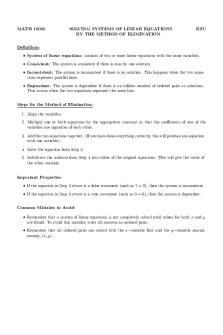2.1 Linear Systems of Equations - Notes PDF

| Title | 2.1 Linear Systems of Equations - Notes |
|---|---|
| Author | Kyle Woodward |
| Course | Physical Geology |
| Institution | Minnesota State University-Mankato |
| Pages | 5 |
| File Size | 51.2 KB |
| File Type | |
| Total Downloads | 72 |
| Total Views | 158 |
Summary
Math 130...
Description
2.1 LINEAR SYSTEMS OF EQUATIONS A linear system of equations is a set of two more linear equations that have the same variables. A linear equation in two variables has the form ax + by = c, where a, b, and c are real constants. A linear equation in n variables has the same form, except that there are n variables with n constants on the left side of the equation. For example,
A solution to a linear system in two variables is a tuple (a pair in the case of two variables) that satisfies each equation in the system. If the system is in two variables, its solution is a pair (x, y) that satisfies every equation in the system. For example, the solution to the system shown before is (1, −2) since 1. (plug into first equation)
2. (plug into second equation)
1
We can also visualize a system of linear equations as a set of (possibly) intersecting lines on a coordinate plane. Let’s consider a linear system of two equations in two variables. There are three possible pictures we can see if we graph two linear equations in two variables: 1. independent system
2. inconsistent system
3. dependent system
The picture below shows these three possibilities:
Methods for solving a linear system of equations There are two algebraic methods for solving a system of linear equations: 1. The Substitution Method 2. The Elimination Method
The Substitution Method 1. Solve one equation for one variable. 2. Plug the resulting expression into the unused equation. 3. Solve for the variable remaining. 4. Plug the solution of one variable into any equation to solve for the other. 5. Write solution as a tuple (x1 , x2 , ..., xn ).
Example. Use the Substitution Method to solve the following linear system. ( 3x − y = 5 x+y = 7
The Elimination Method 1. Add or subtract multiples of equations together so that one variable is eliminated. 2. Solve for remaining variable. 3. Plug the solution of one variable into any equation to solve for the other. 4. Write solution as a tuple (x1 , x2 , ..., xn ).
Example. Use the Elimination Method to solve the following linear system. ( 3x − y = 5 x+y = 7
What does Substitution/Elimination look like when the system is inconsistent (no solution) or dependent (infinitely many solutions)?
Example. Use Substitution or Elimination to solve the following linear system. ( 2x + 4y = −20 −3x − 6y = −36
Example. Use Substitution or Elimination to solve the following linear system. ( −4x + 9y = −27 8x − 18y = 54
Questions for class:...
Similar Free PDFs

Linear-diophantine-equations
- 5 Pages
![Solutions 12.1 [Linear Equations]](https://pdfedu.com/img/crop/172x258/lqr4ljlp92y9.jpg)
Solutions 12.1 [Linear Equations]
- 11 Pages

2.4 Linear-Quadratic Systems
- 5 Pages

FM101 Ch 1 Linear Equations
- 21 Pages
Popular Institutions
- Tinajero National High School - Annex
- Politeknik Caltex Riau
- Yokohama City University
- SGT University
- University of Al-Qadisiyah
- Divine Word College of Vigan
- Techniek College Rotterdam
- Universidade de Santiago
- Universiti Teknologi MARA Cawangan Johor Kampus Pasir Gudang
- Poltekkes Kemenkes Yogyakarta
- Baguio City National High School
- Colegio san marcos
- preparatoria uno
- Centro de Bachillerato Tecnológico Industrial y de Servicios No. 107
- Dalian Maritime University
- Quang Trung Secondary School
- Colegio Tecnológico en Informática
- Corporación Regional de Educación Superior
- Grupo CEDVA
- Dar Al Uloom University
- Centro de Estudios Preuniversitarios de la Universidad Nacional de Ingeniería
- 上智大学
- Aakash International School, Nuna Majara
- San Felipe Neri Catholic School
- Kang Chiao International School - New Taipei City
- Misamis Occidental National High School
- Institución Educativa Escuela Normal Juan Ladrilleros
- Kolehiyo ng Pantukan
- Batanes State College
- Instituto Continental
- Sekolah Menengah Kejuruan Kesehatan Kaltara (Tarakan)
- Colegio de La Inmaculada Concepcion - Cebu











